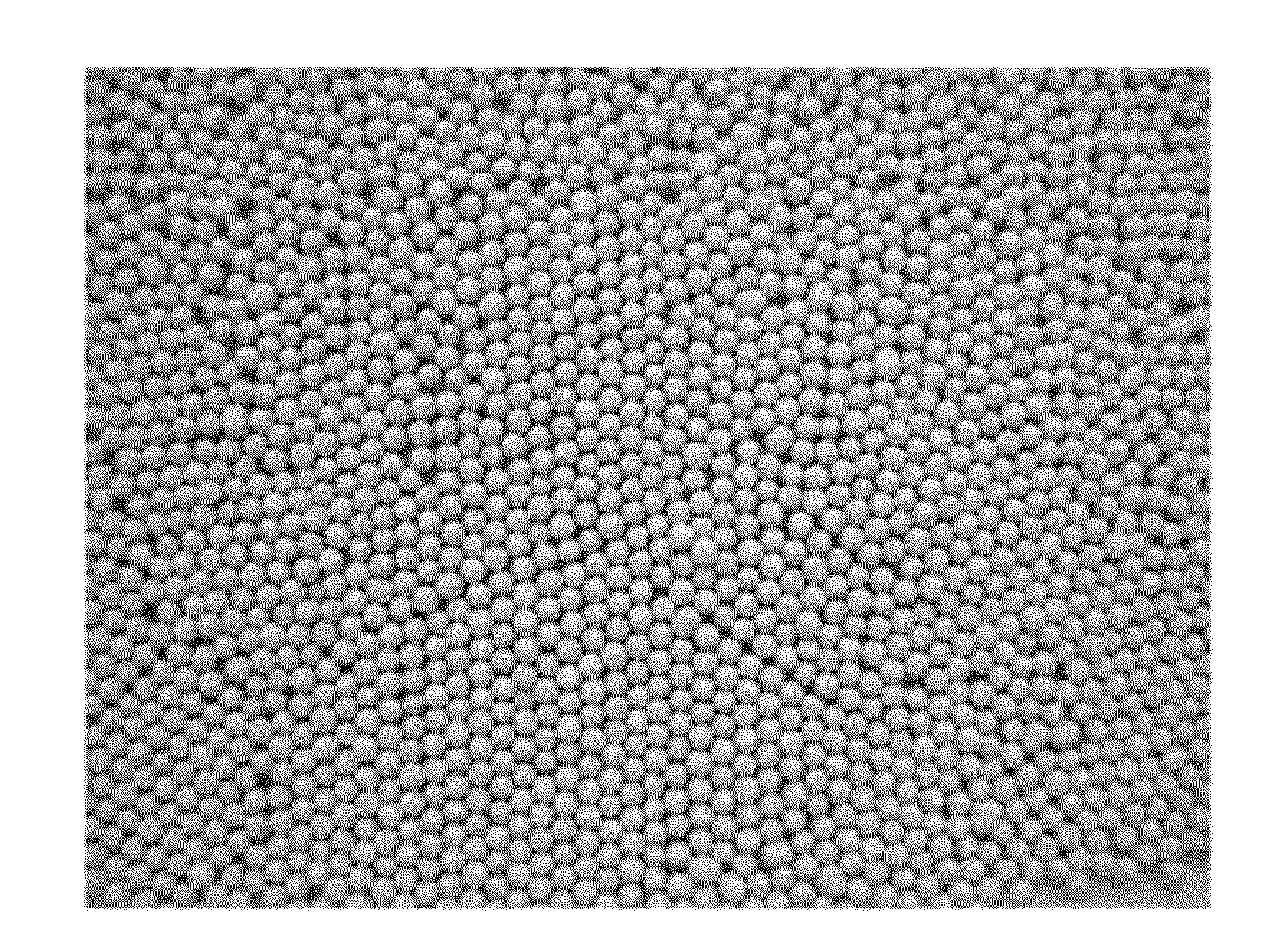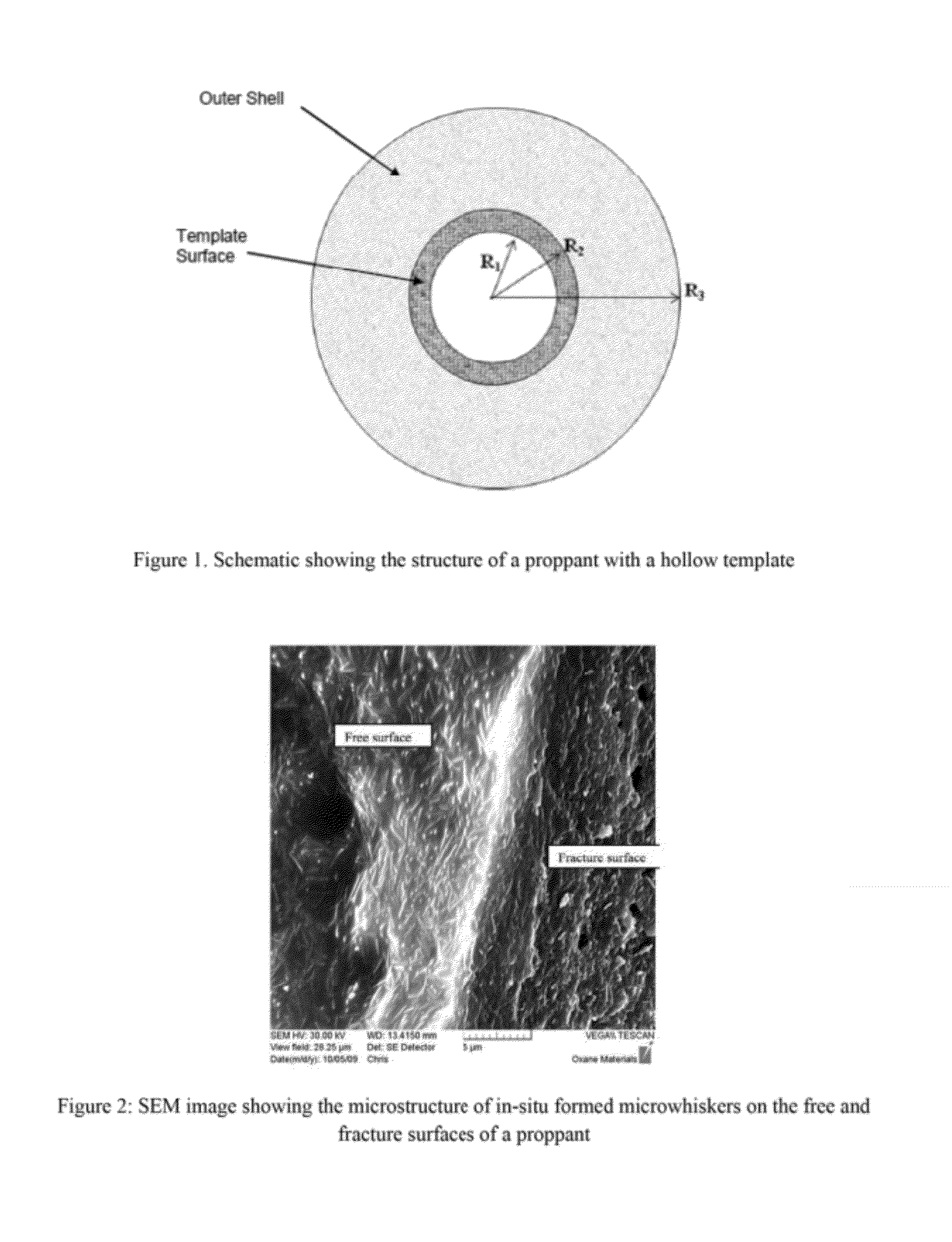Self-Toughened High-Strength Proppant and Methods Of Making Same
- Summary
- Abstract
- Description
- Claims
- Application Information
AI Technical Summary
Benefits of technology
Problems solved by technology
Method used
Image
Examples
example 1
[0448]Sample preparation: Mix cenosphere powder milled to d50=3 μm with alumina powder of d50=0.7 μm in a wet slurry at a weight proportion (wt %) of 44:56. The chemical compositions of the components are shown in Table 1. The mixed slurry was dried and sieved to −200 mesh. The powder was pressed into circular pellets of 12.7 mm (0.5 in) diameter unaxially at 1500-2000 lb pressing force (corresponding pressure: 52.7-70 MPa). The pellets were sintered in an electric furnace at 1250° C. for 6 hours in ambient atmosphere at 10° C. / min ramping rate.
TABLE 1Chemical compositions of the components (in wt %)SiO2Al2O3Fe2O3MgOCaONa2OK2OTiO2Ceno-61.4529.033.960.721.330.441.510.98sphereAlumina99.200.18
[0449]Strength test: The sintered samples were tested for diametral splitting tensile strength according to ASTM C-1144. The splitting tensile strength is calculated as follows:
fst′=2Pπt
where P is the maximum load at failure, and t and d the thickness and diameter, respectively, of the circular pe...
example 2
[0451]In this example, a series of experiments were conducted using various commercially available starting cenospheres or fly ash as one of the starting materials. As shown in Table 2, Examples 2-1 to 2-12 are various cenospheres that were used as the starting material. Examples 2-13 to 2-15 are examples of commercially available fly ash that were used. The wt % of SiO2, Al2O3, Fe2O3, MgO, CaO, Na2O, K2O, TiO2, are shown. In addition, trace amounts of P2O5, MnO, and Cr2O3 were also present. In these examples, the cenosphere (or fly ash) was crushed to a particle size of from about 0.2 microns to about 5.0 microns and this was combined with commercially available alumina (having an average particle size of 0.05 to 5.0 microns) at a weight ratio of 44 wt % cenosphere (or fly ash) / 56 wt % alumina for the examples set forth in Table 3, or 50 wt % cenosphere (or fly ash) / 50 wt % alumina for the examples set forth in Table 4. In the examples, a green body was formed by mixing the crushed...
example 3
[0453]Sample preparation: co-mill mixture of the same type of cenosphere and alumina powders in the same proportion as in Example 1 (44 wt % cenosphere powder and 56 wt % alumina) to d50=0.7 μm. Dry the powder, and sieve the powder to −200 mesh. Press the above powder into circular pellets of 12.7 mm (0.5 in) diameter unaxially at 1500 lb pressing force (52.5 MPa). Sintered the pellets in an electric furnace at 1200° C. for 4 hours in ambient atmosphere at 10° C. / min ramping rate. The diametral splitting tensile strength of the composite sample is 166 MPa (24020 p.s.i.) with 3.09 g / cm3 sintered density. The co-milling process improved homogeneity of the components, while the lower sintering temperature and shorter sintering time led to a lower density. As a result, a stronger structure was achieved although the density is lighter than Example 1.
PUM
| Property | Measurement | Unit |
|---|---|---|
| Length | aaaaa | aaaaa |
| Length | aaaaa | aaaaa |
| Length | aaaaa | aaaaa |
Abstract
Description
Claims
Application Information
 Login to View More
Login to View More - R&D
- Intellectual Property
- Life Sciences
- Materials
- Tech Scout
- Unparalleled Data Quality
- Higher Quality Content
- 60% Fewer Hallucinations
Browse by: Latest US Patents, China's latest patents, Technical Efficacy Thesaurus, Application Domain, Technology Topic, Popular Technical Reports.
© 2025 PatSnap. All rights reserved.Legal|Privacy policy|Modern Slavery Act Transparency Statement|Sitemap|About US| Contact US: help@patsnap.com



